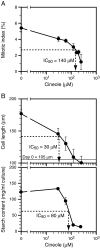1,8-cineole inhibits both proliferation and elongation of BY-2 cultured tobacco cells
- PMID: 21344180
- PMCID: PMC3063882
- DOI: 10.1007/s10886-011-9919-2
1,8-cineole inhibits both proliferation and elongation of BY-2 cultured tobacco cells
Abstract
Volatile monoterpenes such as 1,8-cineole inhibit the growth of Brassica campestris seedlings in a dose-dependent manner, and the growth-inhibitory effects are more severe for roots than hypocotyls. The preferential inhibition of root growth may be explained if the compounds inhibit cell proliferation more severely than cell elongation because root growth requires both elongation and proliferation of the constituent cells, whereas hypocotyl growth depends exclusively on elongation of existing cells. In order to examine this possibility, BY-2 suspension-cultured tobacco (Nicotiana tabacum) cells were treated with 1,8-cineole, and the inhibitory effects on cell proliferation and on cell elongation were assessed quantitatively. Treatment with 1,8-cineole lowered both the mitotic index and elongation of the cells in a dose-dependent manner, and the half-maximal inhibitory concentration (IC₅₀) for cell elongation was lower than that for cell proliferation. Moreover, 1,8-cineole also inhibited starch synthesis, with IC₅₀ lower than that for cell proliferation. Thus, the inhibitory effects of 1,8-cineole were not specific to cell proliferation; rather, 1,8-cineole seemed inhibitory to a variety of physiological activities when it was in direct contact with target cells. Based on these results, possible mechanisms for the mode of action of 1,8-cineole and for its preferential inhibition on root growth are discussed.
Figures





References
-
- ABRAHIM D, BURAGUINI WL, KELMER-BRACHT AM, ISHII-IWAMOTO EL. Effects of four monoterpenes on germination, primary root growth, and mitochondrial respiration of maize. J. Chem. Ecol. 2000;26:611–624. doi: 10.1023/A:1005467903297. - DOI
-
- ABRAHIM D, TAKAHASHI L, KELMER-BRACHT AM, ISHII-IWAMOTO EL. Effects of phenolic acids and monoterpenes on the mitochondrial respiration of soybean hypocotyl axes. Allelopathy J. 2003;11:21–30.
-
- ABRAHIM D, FRANCISCHINI AC, PERGO EM, KELMER-BRACHT AM, ISHII-IWAMOTO EL. Effects of α-pinene on the mitochondrial respiration of maize seedlings. Plant Physiol. Biochem. 2003;41:985–991. doi: 10.1016/j.plaphy.2003.07.003. - DOI
Publication types
MeSH terms
Substances
LinkOut - more resources
Full Text Sources

